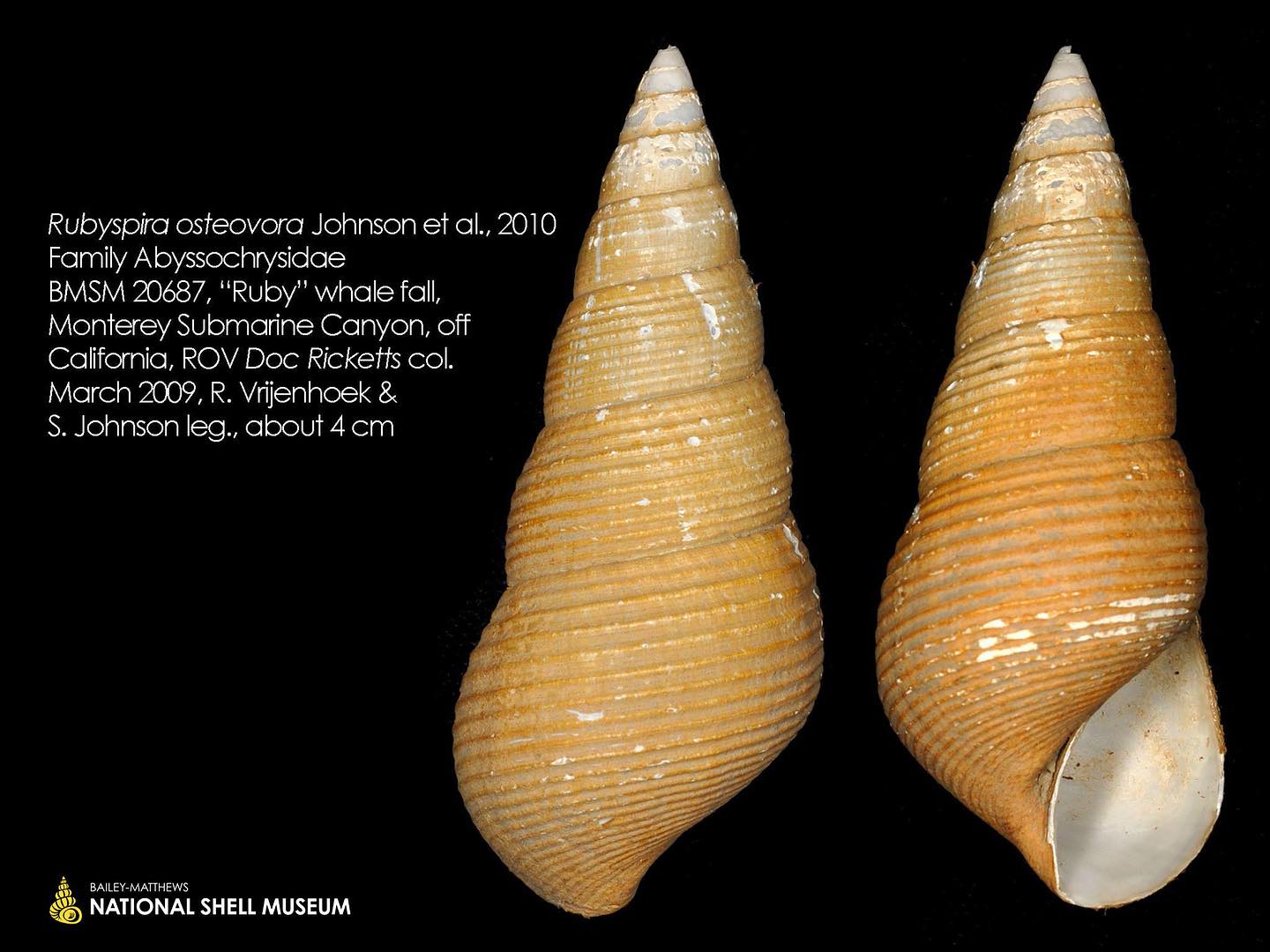Summary:
1. Some mollusks have highly specialized feeding habits.
2. *Rubyspira osteovora* is a deep-sea gastropod that exclusively feeds on whale bones.
3. This species settles on decomposing whale carcasses after most of the flesh has been consumed by other deep-sea scavengers.
4. An aggregation of *Rubyspira osteovora* and other invertebrates can be found on and around whale bones at the Ruby whale fall.
5. The National Shell Museum has received a donated shell from this species for their Deep-sea Mollusks exhibit.
When we think of mollusks, we often imagine them as simple creatures living in shells, slowly crawling on the ocean floor. However, some mollusks have developed highly specialized feeding habits that showcase nature’s incredible diversity and adaptations. One example is *Rubyspira osteovora*, a peculiar deep-sea gastropod that exclusively feeds on whale bones.
Imagine a world deep beneath the ocean’s surface, where the remains of majestic whales rest upon the seafloor. These fallen skeletons, known as whale falls, create a unique ecosystem that supports a wide range of organisms, including the fascinating *Rubyspira osteovora*. This species has adapted to thrive in this unconventional habitat, taking advantage of the abundant food source provided by whale bones.
*Rubyspira osteovora* settles on the decomposing carcasses of whales after other deep-sea scavengers, such as six-gilled sharks, have consumed the bulk of the flesh. This strategy allows the mollusk to minimize competition and instead focus on the nutrient-rich whale bones. With its distinctive reddish spiral shell, *Rubyspira osteovora* forms aggregations on and around the whale bones, creating a mesmerizing sight in the ocean’s depths.
Photographs and videos captured by the Monterey Bay Aquarium Research Institute (MBARI) provide a glimpse into the mysterious world of the Ruby whale fall. At a depth of around 2,900 meters (9,514 feet) in the Monterey Submarine Canyon off the coast of California, an aggregation of *Rubyspira osteovora* and other invertebrates can be observed feasting on the whale bones. These images truly emphasize this species’ unique nature and highlight life’s incredible adaptability in the deep sea.
The National Shell Museum, dedicated to showcasing the beauty and diversity of shells, has received a donated shell from *Rubyspira osteovora*. Drs generously provided this exceptional specimen: Robert Vrijenhoek and Shannon Johnson of the MBARI. The shell, a remarkable representation of this fascinating gastropod, is now a part of the museum’s Deep-sea Mollusks exhibit, captivating visitors with its intriguing tale of specialized feeding habits.
The story of *Rubyspira osteovora* is just one example of the remarkable adaptations found in the animal kingdom. From the vastness of the deep sea to the intricate ecosystems of rainforests, nature constantly surprises us with its ingenuity. It serves as a reminder that every organism, no matter how small or seemingly insignificant, plays a vital role in our planet’s intricate web of life.
As we explore the wonders of the natural world, let us not forget the importance of preserving and protecting these delicate ecosystems. By ensuring the conservation of species like *Rubyspira osteovora* and their unique habitats, we can continue to uncover the hidden secrets of our planet and inspire future generations to appreciate the remarkable diversity of life around us.
Nature never ceases to amaze us, and the specialized feeding habits of mollusks like *Rubyspira osteovora* serve as a testament to the incredible adaptations that have evolved over millions of years. As we delve deeper into the natural world’s mysteries, let us embrace the wonder and awe that comes with each discovery. So next time you admire a seashell or gaze into the ocean’s depths, remember that there is always more to learn and appreciate in the hidden corners of our planet.
*****
Source Description
Some mollusks are highly specialized in their feeding habits. Take, for instance, *Rubyspira osteovora* (no common name), a deep-sea gastropod found only on the fallen skeletons of dead whales (*whale falls*). The species is known to feed exclusively on whale bones; the snail will settle on a decomposing carcass after the bulk of the mammal’s flesh has been eaten by other deep-sea scavengers, including six-gilled sharks.
The deep-sea photo from a Monterey Bay Aquarium Research Institute (MBARI) video shows an aggregation of Rubyspira osteovora and other invertebrates on and around whale bones at the *Ruby* whale fall. The fall is around 2,900 m (9,514 ft) in the Monterey Submarine Canyon, off California. The shell illustrated was donated especially for the *Deep-sea Mollusks* exhibit at the National Shell Museum by Drs Robert Vrijenhoek and Shannon Johnson of MBARI.


